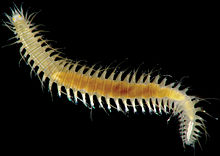| Hesionidae | |
|---|---|

| |
| Oxydromus pugettensis | |
| Scientific classification | |
| Domain: | Eukaryota |
| Kingdom: | Animalia |
| Phylum: | Annelida |
| Clade: | Pleistoannelida |
| Subclass: | Errantia |
| Order: | Phyllodocida |
| Suborder: | Nereidiformia |
| Family: | Hesionidae Grube, 1850 |
| Subfamilies | |
|
Hesioninae | |

Hesionidae are a family of phyllodocid "Bristle worms" (class Polychaeta). They are (like almost all polychaetes) marine organisms. Most are found on the continental shelf; Hesiocaeca methanicola is found on methane ice, where it feeds on bacterial biofilms.[1]
A characteristic apomorphy of the Hesionidae are the cirrophores of the anterior segments, which are well-developed cup-like sheaths; the cirri of the subsequent segments insert into the parapodia directly, or with just a vestigial cirrophore.[2]
- ^ C. R. Fisher; I.'R. MacDonald; R. Sassen; C. M. Young; S. A. Macko; S. Hourdez; R. S. Carney; S. Joye; E. McMullin (2000). "Methane ice worms: Hesiocaeca methanicola colonizing fossil fuel reserves" (PDF). Naturwissenschaften. 87 (4): 184–187. doi:10.1007/s001140050700. PMID 10840806. S2CID 24068068. Archived from the original (PDF) on 2006-02-20.
- ^ Pleijel et al. (2008)